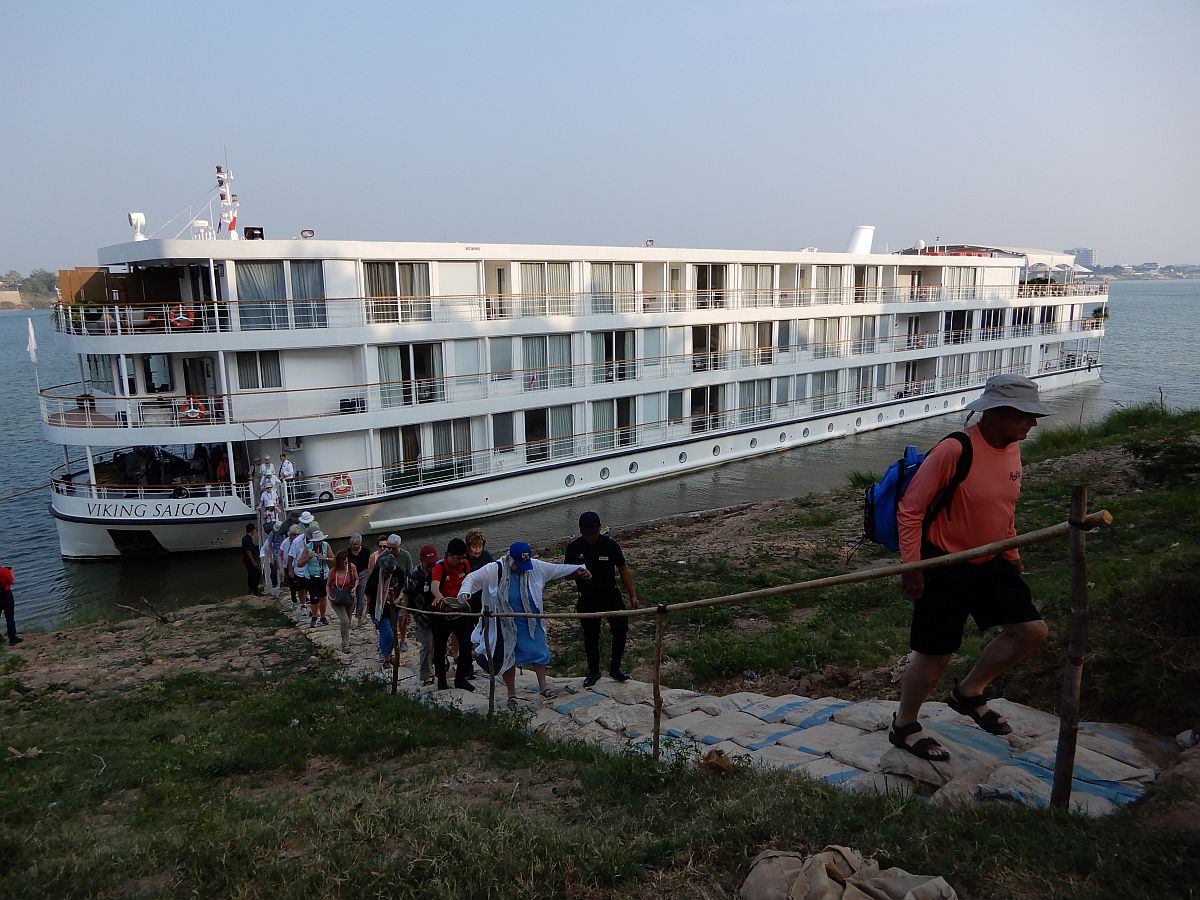
During the following few days, as we cruised down the beautiful River Mekong, we stopped and visited several small villages. Often our mooring spot was somewhat impromptu: a crew-member would jump ashore and tie the mooring ropes to a tree, before putting down a gangplank to reach a stairway of sandbags up the bank to a waiting group of rickshaws. These latter were in a variety of styles, with the passenger seated either in front of or behind the cyclist/motorcyclist, and formed a long moving trail from the river to the village.
 |
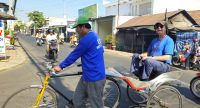 |
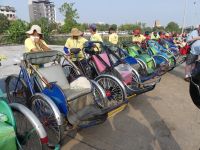 |
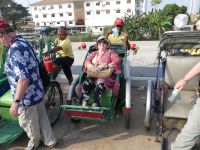 |
 |
Debbie relaxing on the back of her rickshaw* |
... while I relax on mine* |
A long line of rickshaws waits for us |
Debbie relaxes on the front of this one |
The line of rickshaws travels up the road |
Most of the villages were set up as co-operatives, largely populated by women and children survivors of the Khmer Rouge atrocities, being self-sustaining by growing or manufacturing items to sell in the village shop. They were particularly keen to give the children an opportunity to practice their English language skills, and we were often surrounded by groups of children as we walked around. The houses were generally 2 or 3 storeys high; the ground floor was often where animals were kept, or was used as a workshop, and I was interested to see that the floors above were made with a slatted construction to allow a cooling flow of fresh air.
We visited a silversmith village where it was fascinating to watch beautiful jewellery being made by hand, the liquid silver being cast into tiny moulds before the result was hand-worked, but it was far too expensive for us to buy any. By contrast, at one village we watched as they hand-produced beautiful silk items. We saw how the silkworm larvae grew up and how the silk was manually teased from the cocoons before being prepared for weaving and turned into finished goods. These latter were for sale at very reasonable prices in their shop so we just could not resist buying a couple of souvenirs from there!
We then had a short break from village visits, moored at the city of Phnom Penh. I was intrigued to learn about a tributary that joins the Mekong there, namely the Tomle Sap River which is in fact where we were moored. It flows about 70 miles from a huge lake near Siem Reap, but is distinctive in that during the rainy season the level of the Mekong rises so much that the entire length of the Tomle Sap reverses its direction of flow and feeds water back to the lake instead. I have been on tidal rivers many times, but they have always had a tidal interval of slightly over 12 hours, never of a whole year!
We then had a rickshaw-cycle tour of Phnom Penh. The city traffic is totally chaotic, with hundreds of motor-cycles everywhere. They ride on the right-hand side of the road, and on the left-hand side, and in the middle; they go across green traffic lights or red traffic lights, they turn left or right from anywhere on the road, they travel in both directions on one-way streets as well as on the pavement. There are road-signs but they are universally ignored; I guess they don't have a Highway Code book in Cambodia. We were advised that if you wish to cross the road, it is pointless to wait for a gap in the traffic; instead you should simply hold up your hand as a 'stop' signal and walk slowly across the road; the bikes will avoid you, with dozens of them passing you on all sides, but you must not hurry because this may not give them time to change course. It does seem to work but it takes a great deal of nerve!
This rickshaw tour took us to the famous Royal Palace, built in the 19th century during the early period of the French occupation. It is certainly a beautiful palace, although we were rather disappointed in its showpiece 'Silver Pagoda' which boasts a pure silver floor weighing 5 tons. Most of the floor is covered by a carpet to avoid it being damaged, and the small fenced-off area that is visible is never polished (presumably for the same reason) so the tiles just look more like cheap grey slates. I have included just this one picture here, but several more may be found on the 'collections' page.
After we had continued some way down the Mekong, we moored mid-river for several hours while the customs officials checked all the passports and visas; finally we left Cambodia and entered Vietnam. We stayed moored there until the next day, taking the opportunity to observe the wide variety of ships and boats that comprised the local river traffic. Of particular interest to me were the many styles of sampan, characterised by the way their engines drove the propeller directly on a straight shaft with a long tiller giving the necessary leverage to steer it; the entire assembly pivots vertically to place the propeller just below the surface when travelling.
Next morning three large wooden sampans then came alongside, and we boarded them for a brief visit to a floating village which is also a fish-farm. Underneath each house is a 20ft deep fish-pen, accessible through a hole in the floor through which a large mincing machine feeds food to the fish.
The sampans took us along the canal that runs behind 'Evergreen Island', a large local farming community, where we visited the home of a typical Vietnamese farmer and spent some time chatting about their way of life before returning to our ship.
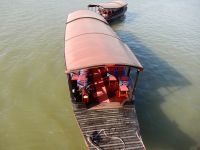 |
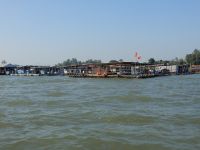 |
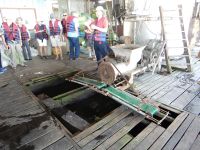 |
 |
Large wooden sampans took us for a tour |
A floating village, which is also a fish farm |
Feeding the fish through a hole in the floor |
Debbie dresses the part for our visit to a farmer's house |
We towed the sampans down the river with us so that they could take us to more towns and villages in the Mekong delta. One town had the most amazing market, selling all sorts of produce including fruits and vegetables, meat fish and poultry (both alive and dead) and a host of other items including small birds which you could buy and then release - this counted as a 'good deed' which would ensure that your Karma would bring you good luck.
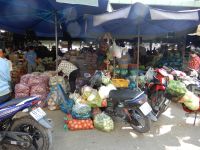 |
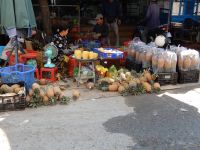 |
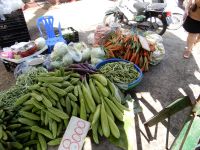 |
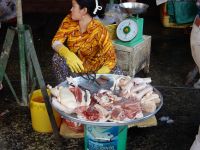 |
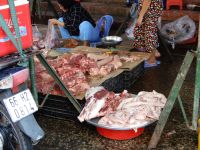 |
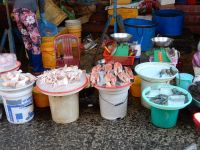 |
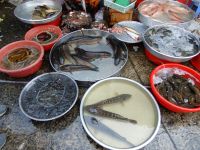 |
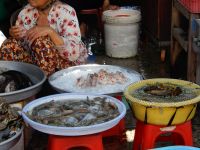 |
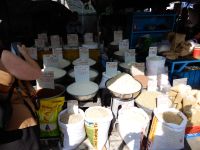 |
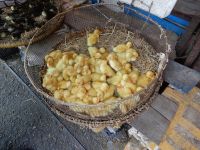 |
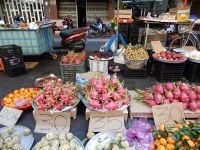 |
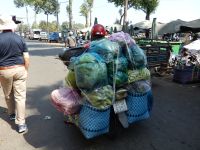 |
At the market in the small town of Sa Dec |
|||
We set off again on the sampans, to visit a small shop where they make and sell wine, spirits, rice-paper, and popped rice sweets. They do not grow grapes there; most of the fermented drinks are based on jackfruit which they grow in their own fields. Rather terrifyingly their speciality is that the bottles also contain snakes and scorpions!
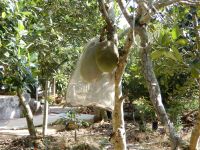 |
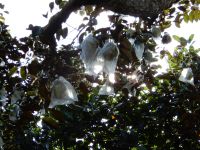 |
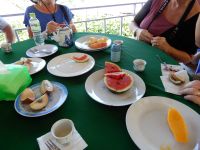 |
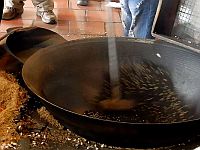 |
Many fruits are grown in the orchard, including Jackfruit and milk-apples; they are enclosed in bags to keep insects out |
We had a delicious meal of many different types of fruit |
Popping rice; the photo doesn't show much but you should see the VIDEO !!! |
|
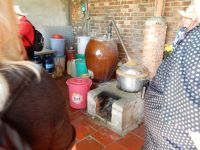 |
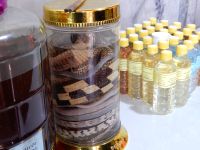 |
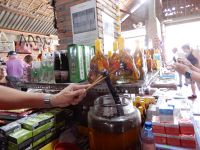 |
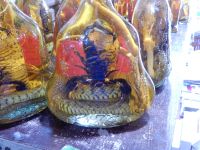 |
They made wine and spirits, fermented and bottled with snakes and scorpions in them |
|||
Our tour later included a visit to one more workshop (actually in Ho Chi Minh City) where they hand-crafted the most exquisitely beautiful lacquer-work items. We watched the whole process, in which up to 16 layers of painted wood, varnish, shell, mother-of-pearl, and similar components are carefully fashioned into a range of finished products. We could not resist buying a couple of items, with a price tag of just 1.5 million Dong (luckily there are more than 30,000 Dong to the Pound sterling - we hoped the credit-card company would remember to make the conversion)
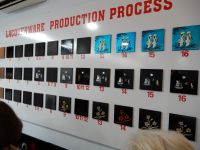 |
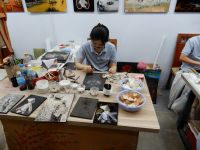 |
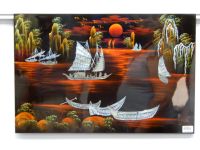 |
 |
The 16 stages in the production of a lacquer-work item |
An artist at work creating beautiful objects |
The finished lacquer-work is just stunningly beautiful |
|
So finally it was time to leave the ship and head for Southern Vietnam and Ho Chi Minh city..
| FlickR album of these photos | Southern Vietnam and Ho Chi Minh City | A page of Temple photos | ||
| Go to Allan's Page | Our Home Page | Holidays Home Page | British Canals Page | Go to Deb's Page |
All pictures on this site are © Allan Jones unless otherwise stated
Pictures captioned with * are © our Viking program director Chung Nguyen